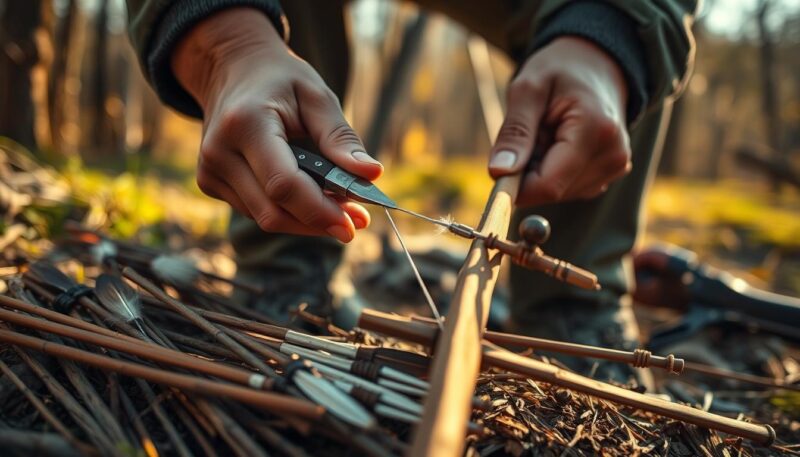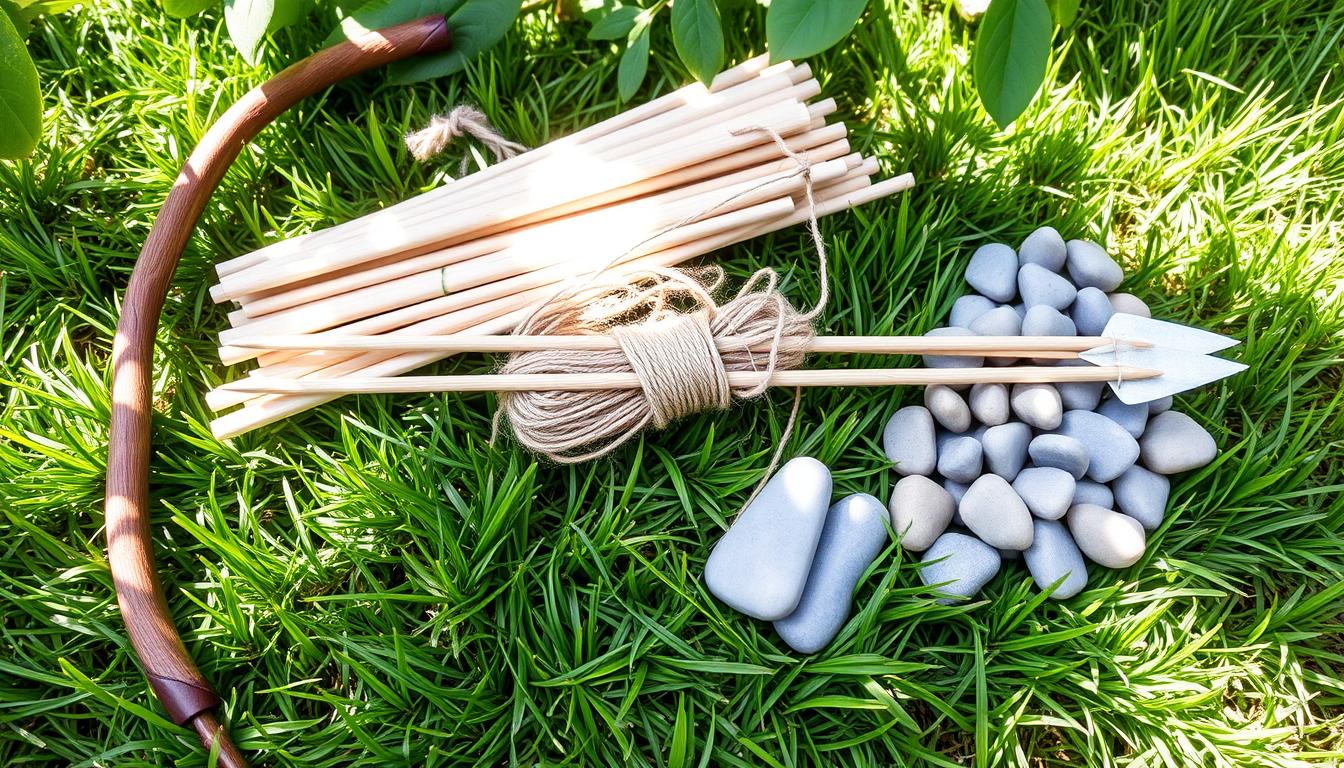The art of making a homemade bow and arrow harkens back to ancient survival skills, utilizing readily available natural materials to create DIY tools for hunting or self-defense. Imagine being out in nature and being able to craft your own survival tool without the need for any fancy equipment. This task might sound daunting, but with the right guidance and a bit of patience, you’ll find it quite straightforward. With simple crafting techniques, you can create an easy bow and arrow set that’s effective and reliable.
For centuries, humans have crafted bows from natural materials, refining their methods over time. Starting with selecting the right piece of wood from flexible, dense trees such as oak, ash, or hickory is crucial. The process blends simplicity and complexity, and even young enthusiasts have successfully crafted minibows of around 12-18 inches in length. By following traditional steps and modern insights, you can tap into this survival skill and craft your very own homemade bow and arrow.
Key Takeaways
- Osage orange, Yew, Black locust, Oak, Ash, and Hickory are popular wood species for making a bow.
- Begin with mini-bows of 12-18 inches in length for easier practice.
- The ideal diameter for selected wood is at least 4 inches; it should be 6 feet in length and free of knots.
- Bow staves must dry for about a week in a cool, dry place, coated on ends to avoid cracking.
- Use rawhide, thin nylon rope, hemp cord, or fishing line for creating bowstrings.
- Essential tools include a Ferrier’s rasp, Nicholson bastard file, and patience for even shaping.
Gathering Your Materials
Jumping into the world of primitive technology starts with understanding the importance of natural materials. Your journey into crafting a homemade bow and arrow involves selecting the right natural resources.
Selecting the Right Wood
The backbone of your bow, wood selection is crucial. Opt for hardwood species such as hickory, oak, Pacific yew, juniper, osage orange, ash, elm, or mulberry. Since seasoned bow staves cost around $60 plus shipping, you might find it more affordable to purchase your wood from a local lumber shop. Ensure your selected wood is straight, over four inches in diameter, and twist-free for a robust and effective bow.
Choosing the Best String
Equally important is choosing the right string. Materials like hemp cord or thin nylon string prove ideal. If you prefer a more modern option, 550 cord is recommended due to its appropriate thickness and minimal stretch. Whichever you choose, make sure it complements your wooden bow to maintain strength and flexibility.
Other Essential Tools
Your venture into primitive technology wouldn’t be complete without essential tools. You’ll need a hand saw for cutting your wood, a metal wedge for splitting, and some sandpaper for smoothing out rough edges. Additionally, having a sharp knife at hand aids in crafting and ensuring the wood can withstand the pressures of usage. Glue made from pine sap can be used to secure arrowheads, completing your basic toolkit.
| Materials | Description |
|---|---|
| Wood | Hickory, Oak, Pacific Yew, Juniper, Osage Orange, Ash, Elm, Mulberry |
| String | Hemp Cord, Thin Nylon String, 550 Cord |
| Tools | Hand Saw, Metal Wedge, Sandpaper, Sharp Knife |
Understanding and gathering these materials ensures you are well-equipped to dive into the next steps of crafting your homemade bow and arrow with natural materials and primitive technology.
Preparing the Bow Stave
Embarking on the journey of crafting your own bow involves understanding the critical steps necessary for preparing the bow stave. This foundation is essential for developing a sturdy and reliable DIY survival weapon, especially significant for wilderness survival and highly regarded by archery enthusiasts. Let’s dive into the process, from finding the perfect bow stave to drying and roughing it out.
Finding the Ideal Bow Stave
Finding the ideal bow stave requires a keen eye. Look for a straight branch with a minimum diameter of 4 inches. Species like hickory, ash, elm, or white oak are excellent choices due to their durability and strength. Prioritize trees that cluster or grow with forks; this ensures you minimize any long-term harm to the tree. Typically, a straight eight-foot segment can potentially yield enough wood to produce four bows, making it a smart and economical choice.
Drying the Bow Stave
Once your stave is selected, the next crucial step is drying it. Contrary to the myth that drying should take a year, placing your stave in a cool, dry place with the ends sealed can effectively expedite the process while preventing cracks. Staves typically decrease significantly in weight during drying. For example, freshly cut staves weighing around 79.5 lbs can drop to as low as 48 lbs post drying, evaporating almost 5 gallons of water content.
Roughing Out Your Bow
Roughing out your bow is an initial yet critical shaping phase that lays the groundwork for the bow’s flexibility and strength. Using tools such as a hatchet, narrow down your stave to rough dimensions. Typically, rough bow stave lengths range between 65 – 70 inches, cut from initial staves measuring around 6’6″ – 7′. This step ensures that the bow’s structure remains robust, aiming for uniformity without compromising the integrity needed for an effective DIY survival weapon.
How to Make a Homemade Bow and Arrow Easy
Crafting a homemade bow and arrow can be both rewarding and empowering. This simple yet powerful tool can serve purposes from self-defense to hunting while teaching you valuable crafting techniques. Follow these steps to shape your bow, cut notches, and ensure balance and flexibility for a successful project.
Shaping the Bow
Shaping your bow involves paying meticulous attention to the natural curve of the wood. Start by ensuring that the upper and lower limbs of the bow mirror each other. Focus on carving the bow’s belly, which is the part that faces you when you draw the bow. It’s essential to remove wood carefully and evenly to achieve a smooth arc, which is crucial for balance and flexibility.

Cutting Notches for the String
Cutting notches at both ends of your bow allows for the bowstring to be securely attached. Use a small file or knife to make these notches, being cautious not to damage the back of the bow. Properly cut notches ensure that the string stays in place, providing stability and reliability, whether you’re preparing for self-defense or hunting.
Ensuring Balance and Flexibility
The key to a powerful and functional bow lies in its balance and flexibility. This is achieved through the process known as tillering. Hang the bow upside down and gradually scrape away wood from the belly of the limbs. Your goal is to make both limbs bend evenly without any sharp bends or soft spots. Using a tillering rack can help maintain consistent pressure and monitor the bow’s arc.
Tillering involves several stages, starting with floor tillering to check the initial bend, followed by more precise adjustments. Regularly stringing and unstringing the bow during this phase allows you to test the flexibility and make necessary corrections. An even, smooth arc ensures that your bow will have the necessary power and accuracy for effective hunting and self-defense.
Crafting your homemade bow and arrow with these techniques can be an enriching experience, offering not only a functional tool but also a deep sense of accomplishment.
Making and Stringing the Bow
In this section, you’ll learn how to craft the bow string, attach it skillfully, and perform tillering to ensure your homemade bow and arrow is effective for various activities, from hunting to survival in the wild.
Crafting the Bow String
Crafting the right bow string is pivotal for your bow’s performance. For a reliable and sturdy choice, consider using Dacron B-50. This material strikes the perfect balance between strength and light weight, allowing your arrows to travel with speed. Create a Flemish loop at one end; this ensures the string can be securely fastened to the bow’s ends, providing the tension required without overburdening the stave.
Attaching the Bow String
Attaching the bow string correctly is crucial for functionality. First, cut precise notches at the ends of your bow limbs to secure the string firmly. When you attach the string, start by looping the Flemish loop end over one of the notches, and then pull the string tightly to the other end. Wrap the string around the bow’s end at least 6-8 times to ensure stability. This step is essential for the bow’s durability and performance, whether for DIY projects or to survive in the wild.
Performing Tillering
Tillering is an essential process that ensures the bow bends evenly and maintains its power. By selectively removing wood from the belly of the limbs, you can allow the bow to achieve a smooth and efficient bend. Start by testing the bend with a tillering stick, making minor adjustments and scraping wood as needed. Pay close attention to the limb’s shape and avoid removing too much wood, which could compromise the bow’s strength. Regularly check the balance and flexibility of the bow, ensuring that both limbs bend uniformly, enhancing its effectiveness for various uses.
FAQ
How to Make a Homemade Bow and Arrow Easy? No Fancy Tools Required
To make a homemade bow and arrow, you’ll need to focus on simplicity and use of natural materials. Select flexible, dense wood and a non-stretchy string. With basic tools like a hand saw or a metal wedge, you can craft a bow suitable for hunting or self-defense.
What Wood is Best for Making a Homemade Bow and Arrow?
The ideal wood types for bow making include oak, ash, hickory, osage orange, yew, and black locust. These woods offer durability and flexibility, essential for a functional DIY survival weapon.
What’s the Best String for a Homemade Bow?
A strong, non-stretchy string is vital. Materials like hemp cord and thin nylon are good options. For optimal performance, Dacron B-50 string is recommended for its strength and lightweight properties.
What Other Essential Tools Do I Need?
Besides wood and string, essential tools include a hand saw, metal wedge, hatchet, and a carving knife. These tools help ensure you can shape the bow stave effectively and create notches for the bowstring.
How Do I Find the Ideal Bow Stave?
Look for a straight branch at least 4 inches in diameter. Choose species that grow in clusters or with forks to reduce harm to the tree. Once cut, dry the stave in a cool, dry place with sealed ends to prevent cracking.
Do I Need to Dry the Bow Stave for a Year?
It’s a myth that drying the stave takes a year. You can expedite the process by drying it in a cool, dry environment and sealing the ends to prevent cracks. Proper drying is crucial for preventing damage and achieving the needed flexibility.
How Do I Rough Out a Bow?
Roughing out involves initial shaping of the stave with tools like a hatchet. This step narrows the stave and lays the foundation for flexibility and tension, aiming for uniformity and strength without weakening the structure.
What Is the Process for Shaping the Bow?
Shaping the bow requires attention to the wood’s natural curve. Create a mirror image curve in the upper and lower limbs, carving only on the belly. Cut notches at each end to hold the bowstring, avoiding damage to the bow’s back.
How Do I Ensure Balance and Flexibility in the Bow?
Tillering is essential. Hang the bow upside down and gradually adjust its bend. This process refines the bow’s flexibility and ensures balanced tension for effective hunting or self-defense.
What’s Involved in Crafting the Bow String?
A strong, lightweight material like Dacron B-50 works best. Create a Flemish loop on the string and attach it to the bow’s ends with precisely cut grooves. This ensures the string supports arrow speed without adding undue weight.
How Do I Attach the Bow String and Perform Tillering?
Attach the bow string to the notches. Perform tillering by adjusting the string’s tension carefully, ensuring the wood bends correctly. This process trains the bow for optimal performance and longevity, crucial for survival situations.
Source Links
- https://wildernessawareness.org/articles/how-to-make-a-bow-and-arrow-part-1/
- https://www.wikihow.com/Make-a-Bow-and-Arrow
- https://wildernessawareness.org/articles/how-to-make-a-bow-and-arrow-part-3/
- https://wildernessawareness.org/articles/bowmaking-basics/
- https://www.popsci.com/story/diy/make-diy-bow-and-arrows-survival/
- https://paleotool.com/2019/11/09/prepping-bow-staves/
- https://sensiblesurvival.org/2009/01/25/primitive-bow-making-part-1/
- https://www.motherearthnews.com/diy/making-a-bow-and-arrow-zmaz84mjzloeck/
- https://www.outdoorlife.com/gear/how-to-make-bow-and-arrow/
- https://researchparent.com/homemade-bow-and-arrows/
- https://buildyourownbow.com/how-to-make-a-simple-bow/
- https://www.instructables.com/How-to-Make-a-Bow-and-Arrow/
- https://4tunate.net/2012/10/simple-outdoor-adventures-for-boys-day-14-make-a-bow-and-arrow/

